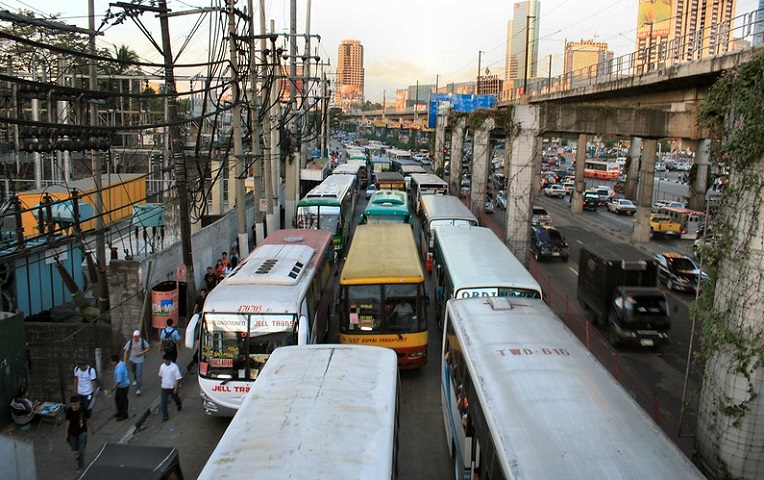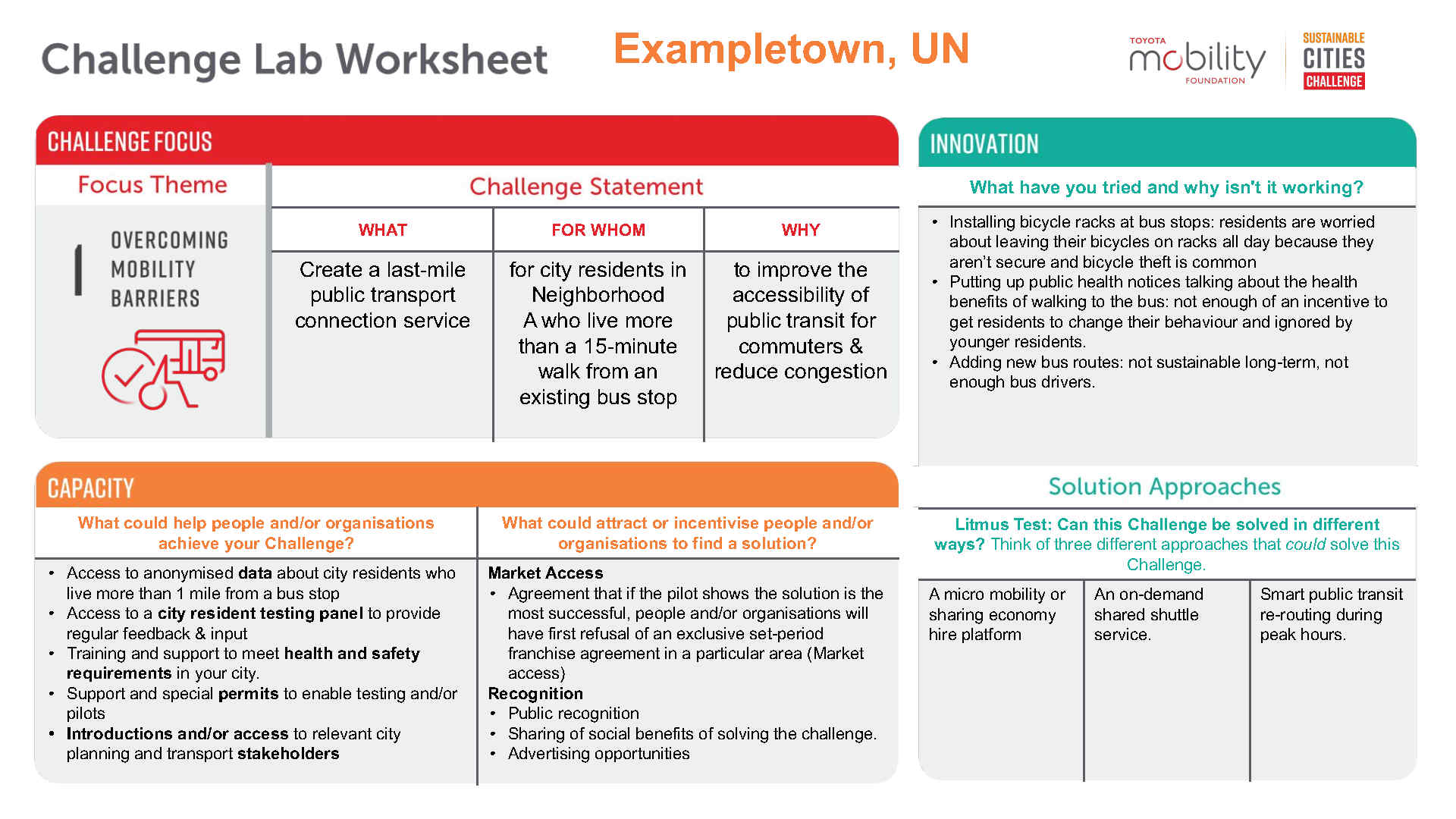
With cities facing population growth, changing work patterns, the climate crisis and ever-widening inequality gaps, improved transportation systems are critical. City governments and local leaders are uniquely positioned to foster innovation to serve public needs. Teaming up with private sector innovators and entrepreneurs through avenues such as innovation challenges, hackathons and prizes, cities have the potential to unleash transformative mobility solutions for local issues, creating tangible societal and environmental benefits for all residents.
What Is an Open Innovation Challenge?
City-based “open innovation” challenges draw on the philosophy that good ideas can come from anywhere and can unlock routes to problem-solving that aren’t typically found in local government procurement processes.
Open innovation challenges are especially useful when it comes to discovering novel approaches and solutions to pressing and unsolved urban issues.
Open innovation challenges usually have the following traits:
- Openness: Through public competition, challenges aim to tap into and engage the broadest possible community of problem solvers.
- Innovation focus: Geared toward a targeted ask, challenges find solutions and approaches to unsolved problems. They are ill-suited for procuring known solutions to existing problems.
- Challenging nature: Open innovation challenges are problem-specific, outcomes-focused and open to a range of potential solutions, with attractive incentives for people and organizations to be motivated to solve them.
A compelling instance of an open innovation challenge is the Climate Smart Cities Challenge, where challenges in Brazil, Colombia, Uganda and the United Kingdom invited innovators and problem solvers who might not traditionally engage with municipal processes to focus their expertise on a city-specific context.
In another example, WRI India in 2018 kicked off the Better Bus Challenge with the aim of co-creating innovation solutions for India’s bus systems. City and transport authorities, entrusted with delivering public services, gained a unique chance to tap into the technical know-how and expertise of private enterprises that have revolutionized the mobility sector with creative and cost-effective solutions. Amplified by matching federal funds, the Better Bus Challenge invited startups to collaborate with transit officials. The ensuing pilot projects in Mumbai, Karnataka and Bengaluru displayed encouraging early outcomes, showcasing improvements in transit service quality and commuter experiences.
In the context of the InoveMob Challenge, supported by the Toyota Mobility Foundation and WRI Brasil, cities and mayors across Brazil eagerly joined forces with the private sector to steer emerging “new mobility” modes towards outcomes that prioritize the public’s best interests—whether making roads safer, easing traffic congestion or improving the safety of women using public transit.
Open innovation challenges can also stimulate local governments to find new ways of working internally, in more agile ways than the conventional business-as-usual framework might allow. The most impactful challenges engage a broad spectrum of actors. A case point is the London Mayor’s Resilience Fund, where the challenge process fostered co-design involving not only city agencies and the startup community, but also civil society and local stakeholders. In city-based challenges, the direct access to city decision-makers, opportunities for engagement with stakeholders and end-users, and the permission to publicly demonstrate solutions have consistently emerged as compelling incentives for potential entrants.
Crafting Impactful Open Innovation Challenges
Based on our experience, formulating impactful open innovation challenges within a city primarily has three essential steps. In essence, this process entails designing a challenge that both yields the outcomes wanted, and effectively engages the right people and businesses necessary to bring those outcomes to fruition.
First, organizers need to identify and understand the problem or issue to address, and who is affected by it. The next step is to define a challenge statement, which serves as a clear outline of the primary “ask” to be presented to an open community of problem solvers. This succinct statement, often in a sentence or two, should sum up the following key points:
- What: The ask to individuals, organizations or entrepreneurs for their inventive inputs.
- For Whom: Intended beneficiaries of the solution or approach, which could involve specific individuals, communities or neighborhoods.
- Why: Rationale behind addressing this problem, outlining the desired outcomes that would emerge from its successful resolution.
Examples of good challenge statements include:
- Create innovative business models, services and/or products that can help shape a new housing development appraisal and financing model that enables the development of affordable, zero carbon new homes in the city of Bristol starting in 2023. More about the Bristol Climate Smart Cities Challenge
- Create a financially sustainable fit-out solution for empty commercial and community space in new developments, to enable local businesses and community organizations to easily and affordably occupy new space in the Borough of Hackney. More about the Affordable Workspace Challenge
- Create solutions to decarbonize the heating of Helsinki, using as little biomass as possible. More about the Helsinki Energy Challenge

An important note for crafting a strong challenge statement is how it differs from a procurement exercise, such as acquiring an electric bus fleet. The statement should put forth a particular problem and then invite innovators with different expertise to take it on and create solutions, rather than be prescriptive.
Finally, once organizers have defined the challenge, they need to issue a “call to innovators,” thinking through what support and incentives need to put in place to enable innovation to thrive – for example, what data, stakeholders, permissions or funding needs to be put in place? Challenge Work’s practice guide has some useful tips for exploring what this could look like.
Urban transport and mobility systems profoundly influence the shape and character of a city, how well it functions in a crisis, its impact on the environment and whether people can access the opportunities they need. While innovations in urban transportation have abounded in recent years, we need to ensure that innovative solutions promote equity and safety for all, and protect our planet’s resources for future generations. In this pursuit, open innovation challenges can be a vital catalyst, presenting one effective approach to drive progress.
The $9-million Toyota Mobility Foundation Sustainable Cities Challenge is currently accepting entries from cities worldwide until September 18, 2023. This opportunity allows cities to define and present their mobility challenges and attract innovators to address these barriers. Interested cities can register for one-on-one sessions for any inquiries.
An earlier version of this blog appeared on ChallengeWorks.org.
Catherine Thompson is a Program Manager at Challenge Works.
Kathy Nothstine is the Head of Future Cities at Challenge Works.
Thet Hein Tun is a Senior Transportation Research Associate at WRI.






